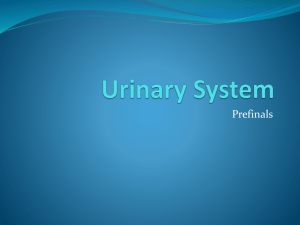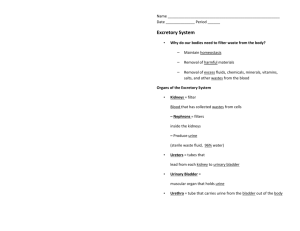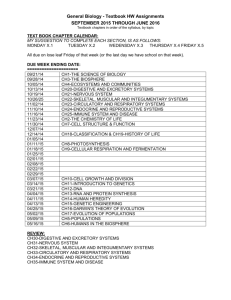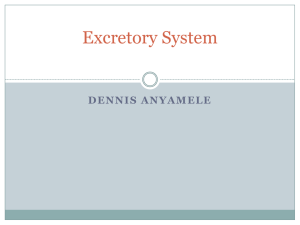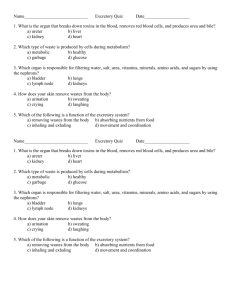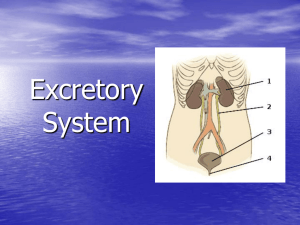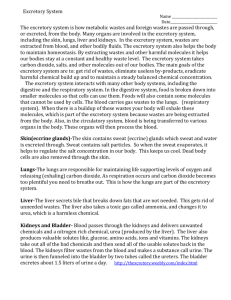Theme: X-rays and radioisotopic diagnostics of urological diseases.
advertisement
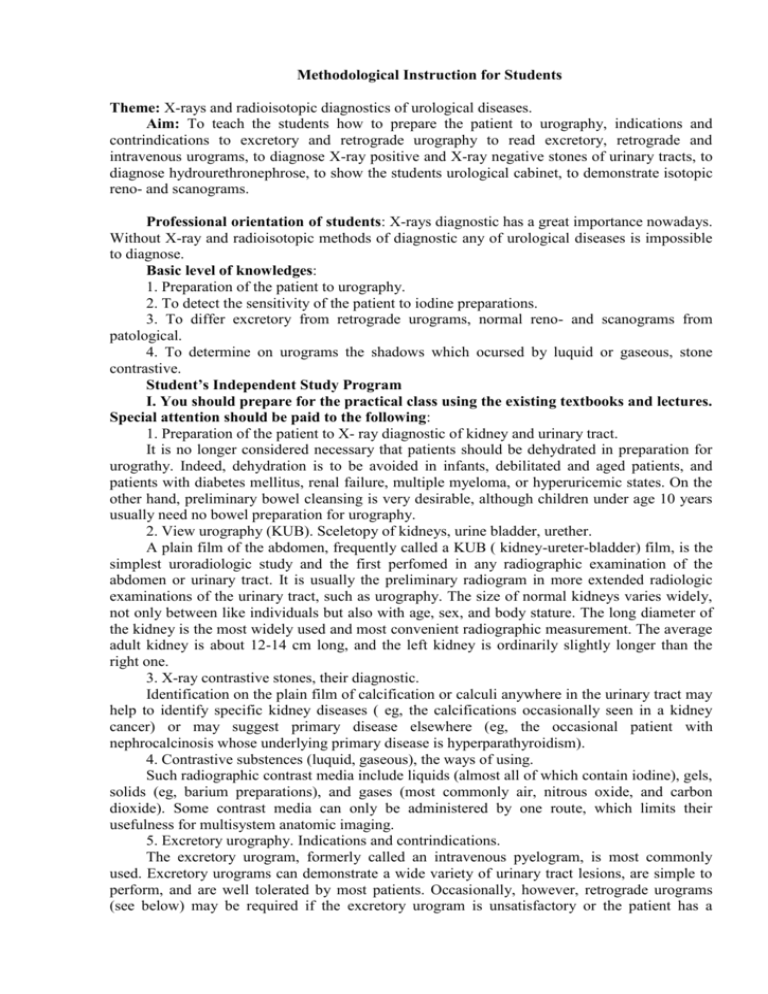
Methodological Instruction for Students Theme: X-rays and radioisotopic diagnostics of urological diseases. Aim: To teach the students how to prepare the patient to urography, indications and contrindications to excretory and retrograde urography to read excretory, retrograde and intravenous urograms, to diagnose X-ray positive and X-ray negative stones of urinary tracts, to diagnose hydrourethronephrose, to show the students urological cabinet, to demonstrate isotopic reno- and scanograms. Professional orientation of students: X-rays diagnostic has a great importance nowadays. Without X-ray and radioisotopic methods of diagnostic any of urological diseases is impossible to diagnose. Basic level of knowledges: 1. Preparation of the patient to urography. 2. To detect the sensitivity of the patient to iodine preparations. 3. To differ excretory from retrograde urograms, normal reno- and scanograms from patological. 4. To determine on urograms the shadows which ocursed by luquid or gaseous, stone contrastive. Student’s Independent Study Program I. You should prepare for the practical class using the existing textbooks and lectures. Special attention should be paid to the following: 1. Preparation of the patient to X- ray diagnostic of kidney and urinary tract. It is no longer considered necessary that patients should be dehydrated in preparation for urograthy. Indeed, dehydration is to be avoided in infants, debilitated and aged patients, and patients with diabetes mellitus, renal failure, multiple myeloma, or hyperuricemic states. On the other hand, preliminary bowel cleansing is very desirable, although children under age 10 years usually need no bowel preparation for urography. 2. View urography (KUB). Sceletopy of kidneys, urine bladder, urether. A plain film of the abdomen, frequently called a KUB ( kidney-ureter-bladder) film, is the simplest uroradiologic study and the first perfomed in any radiographic examination of the abdomen or urinary tract. It is usually the preliminary radiogram in more extended radiologic examinations of the urinary tract, such as urography. The size of normal kidneys varies widely, not only between like individuals but also with age, sex, and body stature. The long diameter of the kidney is the most widely used and most convenient radiographic measurement. The average adult kidney is about 12-14 cm long, and the left kidney is ordinarily slightly longer than the right one. 3. X-ray contrastive stones, their diagnostic. Identification on the plain film of calcification or calculi anywhere in the urinary tract may help to identify specific kidney diseases ( eg, the calcifications occasionally seen in a kidney cancer) or may suggest primary disease elsewhere (eg, the occasional patient with nephrocalcinosis whose underlying primary disease is hyperparathyroidism). 4. Contrastive substences (luquid, gaseous), the ways of using. Such radiographic contrast media include liquids (almost all of which contain iodine), gels, solids (eg, barium preparations), and gases (most commonly air, nitrous oxide, and carbon dioxide). Some contrast media can only be administered by one route, which limits their usefulness for multisystem anatomic imaging. 5. Excretory urography. Indications and contrindications. The excretory urogram, formerly called an intravenous pyelogram, is most commonly used. Excretory urograms can demonstrate a wide variety of urinary tract lesions, are simple to perform, and are well tolerated by most patients. Occasionally, however, retrograde urograms (see below) may be required if the excretory urogram is unsatisfactory or the patient has a history of significant adverse reaction to intravascular contrast media. The advent of excretory urography using high volumes of radiopaque contrast media and ureteral compression (see below) has decreased the need for retrograde urograms. 6. The types of excretory urograms. Abdominal (ureteral) compression devices that temporarily obstruct the upper urinary tracts during excretory urograms dramatically improve the filling of renal collecting structures. 7. Retrograde urography. Method, indications and contrindications. Retrograde urography is a moderately invasive procedure that requires cystoscopy and the placement of catheters in the ureters. A radiopaque contrast medium is introduced into the ureters or renal collecting structures through the ureteral catheters, and tadiograms of the abdomen are then taken. The study, which is more difficult than an excretory urogram, must be perfomed by a urologist. Some type of local or general anesthesia must be used, and the procedure can occasionally cause later morbidity or urinary tract infection. 8. Infusional urography, indications. The use of greater than average amounts of standard contrast medium – and thus greater amounts of iodine per kilogram of body weight – may be indicated in selected patients. The high volumes may be injected either rapidly as a bolus or more slowly as an infusion; the bolus method produces better visualization and a better urographic nephrogram than the infusion method. 9. Cystography, its types. A cystogram is a radiogram showing radiopaque outlining of the bladder cavity. Cystograms are seen as part of ordinary excretory urograms, but direct radiographic cystograms can be obtained by instilling a radiopaque fluid directly into the bladder. The contrast medium is usually instilled via a transurethral catheter, but when necessary, it can be administered via percutaneous suprapubic bladder puncture. Radiograms of the filled bladder are taken using standard overhead x-ray tube equipment, or less frequently, “spot” films are taken during realtime, direct, image-intensified fluoroscopy. 10. Urethrography. Method, indications and contrindications. The urethra can be imaged radiographically by retrograde injection of radiopaque fluid or in antegrade fashion with voiding cystourethrography. The antegrade technique is required when lesions of the posterior urethra, eg, posterior urethral valves, are suspected; the retrograde technique is more useful for examining the anterior urethra. An antegrade urethrogram can also be obtained by taking radiograms as the patient voids at the termination of an excretory urogram, when the bladder is filled with contrast medium. 11. Antegrade urography. This method of outlining the renal collecting structures and ureters is occasionally used when urinary tract imaging is necessary but excretory or retrograde urography has failed or is contraindicated or when there is a nephrostomy tube in place and delineation of the collecting system of the upper urinary tract is desired. The contrast medium is introduced either through nephrostomy tubes, if these are present (nephrostogram), or by direct injection into the renal collecting structures via a percutaneous puncture through the patient`s back. 12. Method, indications and contrindications for arteriography of the kidneys. Anteriographic study of the kidneys is performed almost exclusively by percutaneous needle puncture and catheterization of the common femoral arteries or, much less often, the axillary arteries. Rapid serial radiograms are obtained during and aften bolus injection of suitsble radiopaque contrast medium into the aorta at the level of the renal arteries (aortorenal arteriogram, “flush” abdominal aortogram) or into one of the renal arteries (selective renal arteriogram). 13. Isotopic renography. Radioisotopic techniques provide a means of investigating the structure and function of internal organs without disturbing normal physiologic processes. Currently, 4 general types of renal radioisotopic labels are used. Classified according to the mechanisms of labeling, they are as follows: (1) renal cortex labels, which are retained in the renal tubular cells; (2) intravascular comparment labels; (3) renal tubular function labels, which briefly label the renal cortex as they are accumulated by renal tubular cells and then are passed into the urine and cleared from the kidney; and (4) substances cleared solely by glomerular filtration, which allow determination of the glomerular filtration rate. Real life situation to be solved: 1. Patient S., 28 years. During intravenous infusion of 76% urographine (3 ml), starts voumiting, headache, and apnoe. A. What does it mean? B. Your tactics? 2. Women K., 67 years. In anamnesis urolithic disease with small stone exretion. In blood: glucose 5,4; urea 10,3; creatinine 0,18m. mols/l. A. What type of excretory urogram is necessary to use? B. Methodic of excretory urogram. Tests. 1. What of this preparation must be used for excretory urography? A. Iodlipole B. Urographyne C. Barium D. Bilitrast E. Bilignost 2. What of this preparation neutralise iodcontent substences? A. Natrium Thyosulfate B. Magnium sulfate C. Dimedrole D. Prednisolone 3. What is the volume of kidney cavity? A. 10-15ml. B. 15-20ml. C. 5-6ml. D. 20-25ml. E. 2-3ml. Answers: 1. a. Alergical reaction on iodcontent preparation. b. To stopped inffusion of urographyne, it is necessary to inffuse Natrium Thyosulfate. 2. a. Inffusional urography. b. 60ml. of contrast +120ml. NaCl 0,9% to inffuse intravenous slowly. Tests: 1-B; 2-A; 3-C. Student should know: 1. View urography. 2. Excretory urography. Indications and contrindications. 3. Methods of excretory urography. 4. The types of excretory urograms. 5. Retrograde urography. 6. Antegrade uretherography. 7. Cystography, its types. 8. Angiography. 9. Echographia, scanograms. Student must be able to: 1. Prepare the patien to urography. 2. Determine indications and contrindications for excretory and retrograde urography. 3. Read view and contrastive urograms, isotopic reno- and scanograms. 4. Diagnose X- ray possitive stones of urine tracts with other same shadows. 5. Diagnose hydronephrose, anomalies of development the kidneys (anomalies of quantity, situation, structure).
